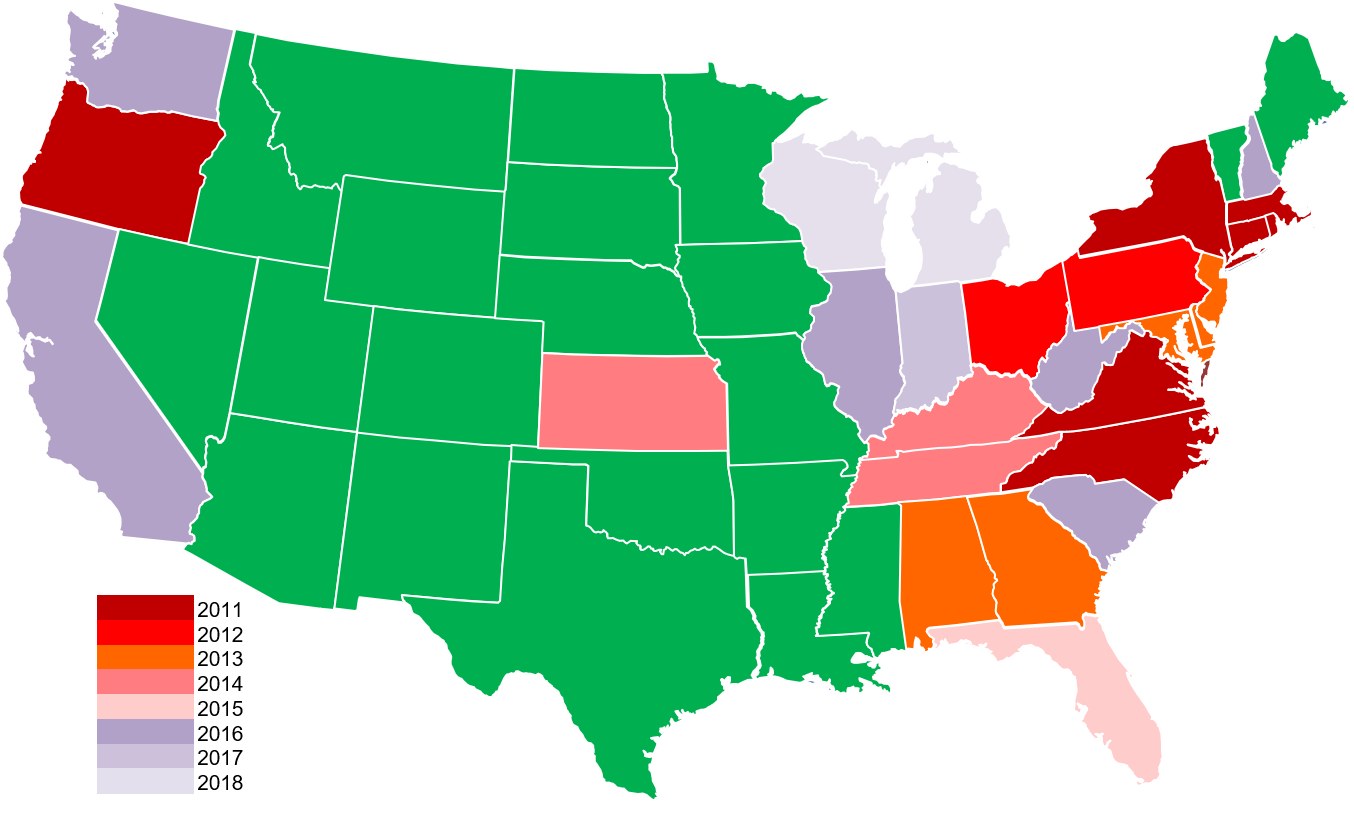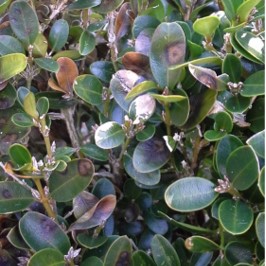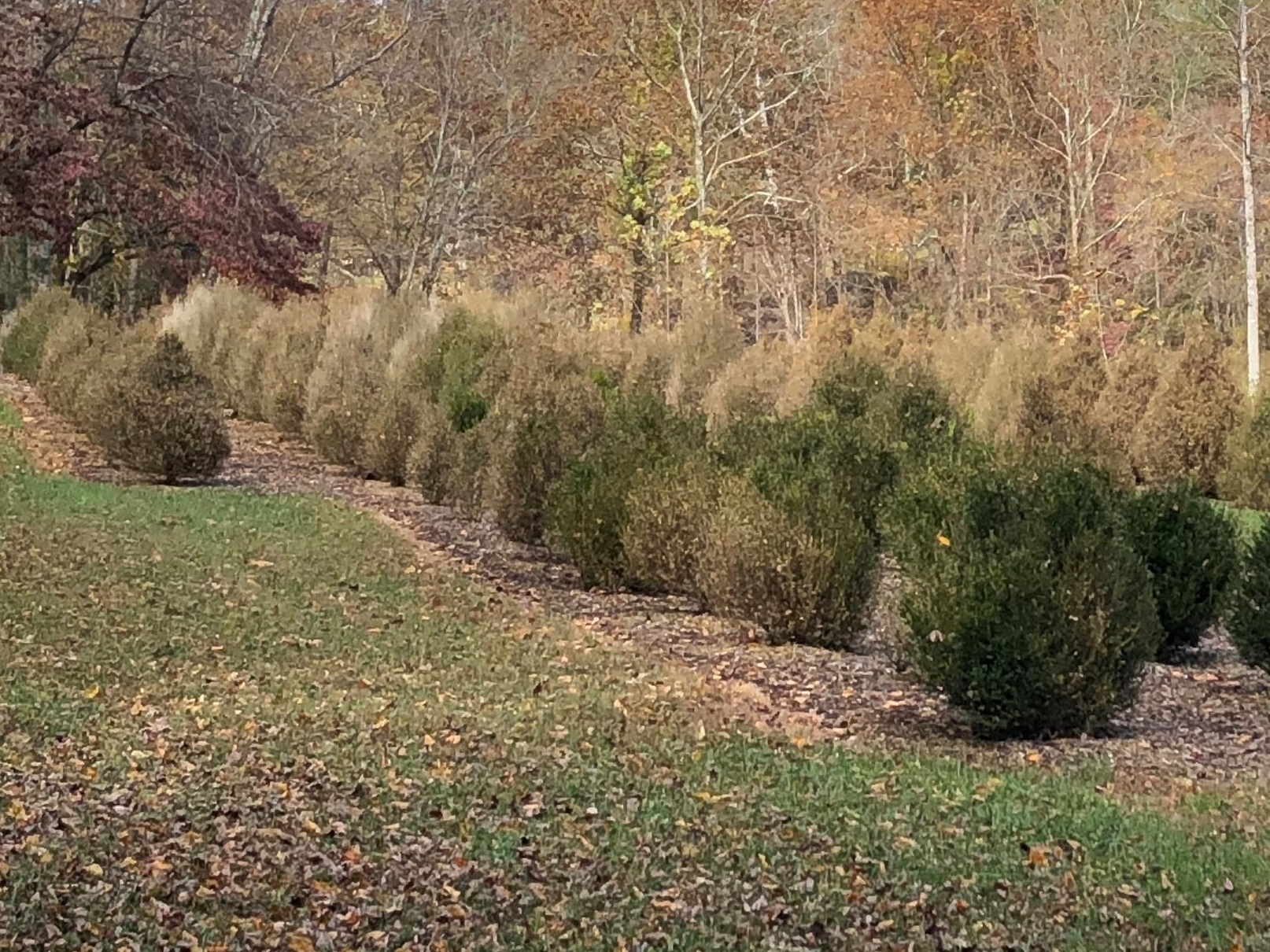Since Boxwood Blight was found in the United States in 2011, researchers and growers have been diligently working to understand this pathogen. Although the disease has spread to 28 states since its initial identification in North Carolina, there have been many breakthroughs in the understanding of the biology of the disease and how to control it.
Map of states with known cases of Boxwood Blight as of 2018
Boxwood Blight is a fungal disease caused by the pathogen Cylindrocladium buxicola (syn. Calonectria pseudonaviculata). The pathogen attacks the foliage of boxwood, first appearing as black or dark brown spots on the leaves. In a few days, those spots will develop yellow to brown rings around them and cover the leaf. Infected leaves fall off the plant in a matter of a week or so, and stems near infected leaves will develop streaked black lesions or cankers.
The disease is most prevalent when environmental conditions favor warm temperatures between 60° - 80° F and high humidity. Leaves that are continually wet from constant irrigation, prolonged rain, or high humidity are prime targets for the pathogen. When conducive conditions subside, the fungus will go dormant in the form of black streaks in the limbs of affected plants or debris. The fungus can lie inactive for long periods of time and reappear when conditions become conducive again.
Here you can see the north side of the plant getting the disease first. There is almost an exact line because the north side gets less sunlight and dries more slowly.
The Boxwood Blight spore is heavy and sticky, and is typically introduced through contact with infected plants, debris, tools and equipment, clothing, animals, water splash, or other means of direct contact.
Currently, the only known hosts of the pathogen are members of the Buxaceae family, Buxus sp. (Boxwood), Sarcococca sp. (Sweetbox), and Pachysandra sp (Spurge).
With a better understanding of the disease lifecycle and its optimal conditions, there are many practical ways to prevent and control the spread.
Because the spores can spread from plant to plant on clothing, tools, or splashing water, anyone working around boxwood should start with clean clothes, shoes and tools. Make sure to properly clean tools and equipment with disinfecting agents like alcohol, bleach, or Lysol before and after use in boxwood. If you are a landscaper moving from site to site, you should use a disinfectant on clothing and shoes, or use disposable pant and boot covers between sites. Starting with and maintaining clean equipment can remove the pathogen from ever entering a new site.
Spores of the pathogen can also spread through water so it is best to avoid overhead irrigation when possible. Facilitating an irrigation schedule that allows just a 3 hour period of dryness for the leaves can significantly reduce the spread of the disease. When there are periods of dry foliage, the leaves are far less likely to become infected, even if the spores are introduced. Never use overhead irrigation in the late afternoon because leaves will remain wet all night. Maintain good air flow when planting and pruning the plants to ensure leaf drying. Recent studies have also shown that mulching every two years or so with at least an inch of mulch around the base of the plant can lessen water splashing.
Studies have shown that, when tested in a lab, all boxwood cultivars show some susceptibility to blight. However, many field tests have shown significant differences in tolerance between cultivars. We have observed certain cultivars, particularly the microphylla, insularis, and harlandii species show strong tolerance compared to those with sempervirens genetics. Shape and structure of the boxwood also affect each plant’s tolerance. Open, more upright plants tend to be more tolerant while short, compact cultivars seem to be more susceptible. We believe this is because the shorter plants that are close to the ground get more water splashing on them. Research is ongoing to discover additional cultivars that will be tolerant to boxwood blight.
A photo of Buxus ‘SB 108’ NewGen Independence™ next to an American Boxwood, planted on the same site for 3 years.
The exciting results we have seen with varietal tolerance inspired us to create the NewGen™ Boxwood brand. We believe the combination of tolerant varieties and best management practices like those we have outlined are the future of an industry that doesn’t fear Boxwood Blight. For more information check out our education page on Boxwood Blight and subscribe for monthly newsletters filled with the most relevant and up-to-date information and research on boxwood.

















